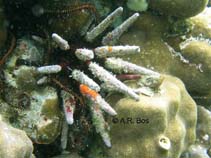Phyllacanthus imperialis Lamarck, 1816
Lance urchin| Native range | All suitable habitat | Point map | Year 2050 |

|
| This map was computer-generated and has not yet been reviewed. |
| Phyllacanthus imperialis AquaMaps Data sources: GBIF OBIS |
Classification / Names প্রচলিত নাম সমূহ | প্রতিনাম সমূহ | CoL | ITIS | WoRMS
Echinoidea | Cidaroida | Cidaridae
Environment: milieu / climate zone / গভীরতার পরিসীমা / distribution range বাস্তুসংস্থান
রীফ সংশ্লিষ্ট; গভীরতার পরিসীমা 0 - 73 m (সূত্র 95661). Tropical
Distribution দেশ সমূহ | এফ এ ও এলাকাসমূহ | বাস্তুতন্ত্র | দৃষ্টিগোচর | প্রচলন
Indo-West Pacific: East Africa and the Red Sea to Australia and Japan.
Length at first maturity / আকৃতি / Weight / Age
পরিপক্কতা : Lm ? range ? - ? cm Max length : 7.0 cm WD পুরুষ/ লিঙ্গ অনিধর্ারিত ; (সূত্র 800)
Life cycle and mating behavior পরিপক্কতা | প্রজনন | ডিম ছাড়া | Eggs | ডিম্বধারন ক্ষমতা | Larvae
Main reference
সূত্র সংখ্যা | সমম্বয়কারী | সহযোগী
Schoppe, S. 2000 A guide to common shallow water sea stars, brittle stars, sea urchins, sea cucumbers and feather stars (echinoderms) of the Philippines. Times Media Private Limited, Singapore. 144 p. (সূত্র 800)
IUCN Red List Status
(সূত্র 130435: Version 2025-1)
CITES status (সূত্র 108899)
CMS (সূত্র 116361)
Threat to humans
Human uses
| FishSource |
হাতিয়ার
আরো তথ্য
Max. ages / sizes
Length-weight rel.
Length-length rel.
Length-frequencies
Mass conversion
প্রাচুর্য
ইন্টারনেট সুত্র
BHL | BOLD Systems | CISTI | DiscoverLife | FAO(Publication : search) | Fishipedia | GenBank (genome, nucleotide) | GloBI | Gomexsi | Google Books | Google Scholar | Google | PubMed | জীবন বৃক্ষ | Wikipedia (Go, অনুসন্ধান ) | জুলজিকাল রেকর্ড



